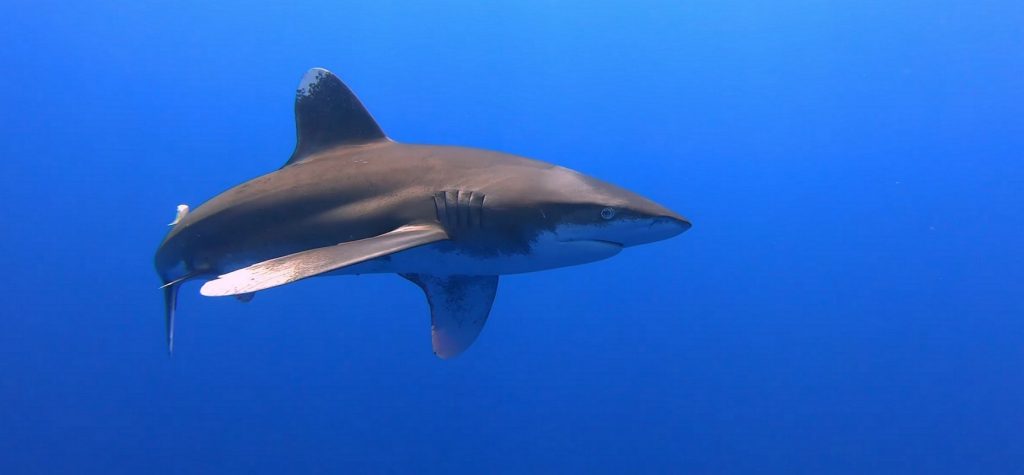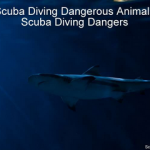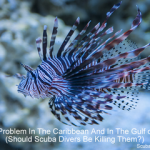
If you’ve never dived the Red Sea before, you are in for a treat as the diving is amazing, but are there dangerous fish in the Red Sea you need to be aware of?
Dangerous fish in the Red Sea include Lionfish, Stonefish, Scorpion fish, Barracuda, Moray eels, Titan triggerfish and Red Sea sharks.
The Red Sea is home to a diverse array of marine life, including some species of fish that can be dangerous to humans. Here are some of the most notable examples:
- Red Sea Lionfish: These fish have venomous spines that can cause painful and potentially dangerous stings.
- Stonefish: Found in shallow waters, these fish are masters of camouflage and have spines that release a venom that can be lethal to humans. They are known for their remarkable camouflage that allows them to blend in with the surrounding environment, making them difficult to spot.
- Scorpion fish: The stonefish is a highly venomous fish that is found in the shallow waters of the Red Sea.
- Barracuda: These predatory fish have sharp teeth and can be aggressive towards humans if they feel threatened.
- Moray eels: These eels have powerful jaws and sharp teeth that they use to catch their prey. While they are generally not aggressive towards humans, they can be dangerous if provoked or cornered.
- Titan triggerfish: Titan triggerfish will attack divers, especially in the nesting season, and if divers swim too close to their nest.
- Red Sea sharks: Sharks can be dangerous, but usually only when provoked, so mostly it is safe to scuba dive with sharks in the Red Sea. However, the sharks you need to be careful around are the oceanic whitetips, which have been know to attack divers. This has happened when oceanic whitetips attacked divers at The Brothers Islands, and at Elphinstone Reef too.
It’s important to exercise caution when swimming or diving in the Red Sea and to avoid touching or disturbing any marine life. If you do get stung or bitten by a fish, seek medical attention immediately.
Before reading more about each of these Red Sea dangerous creatures, please take a look at this window of Red Sea liveaboards:
Red Sea Lionfish
The Red Sea Lionfish is a venomous fish that is native to the Red Sea and the Indian Ocean. They are also known as zebrafish, firefish, or turkeyfish due to their colourful stripes and spiky appearance. Lionfish have a distinctive look with large, fan-like fins and venomous spines that can deliver a painful sting.
Lionfish are not naturally aggressive towards humans, but they can sting when they feel threatened or cornered. The venom in their spines can cause extreme pain, swelling, and other symptoms in humans. In rare cases, a lionfish sting can cause more severe symptoms, such as difficulty breathing or paralysis.
If you are stung by a Red Sea Lionfish, it’s important to seek medical attention immediately. Symptoms of a sting may include intense pain, swelling, and redness around the affected area, as well as nausea, vomiting, and difficulty breathing. Treatment may include the administration of antivenom and pain medication, as well as soaking the affected area in hot water to help alleviate pain and promote blood flow.
To avoid getting stung by a Red Sea Lionfish, it’s important to be aware of your surroundings and to avoid touching or interacting with any fish that you see. If you are snorkeling or diving, maintain a safe distance from any fish and avoid disturbing them. If you do come across a lionfish, do not touch it and instead alert your diving or snorkeling guide.
Stonefish
The stonefish is a highly venomous fish that is found in the shallow waters of the Red Sea, as well as in other tropical and subtropical regions around the world. They are known for their remarkable camouflage that allows them to blend in with the surrounding environment, making them difficult to spot.
The stonefish’s venom is delivered through spines that are located on its back. These spines are hollow and contain venom-producing glands. When the fish feels threatened or is stepped on, the spines can inject venom into the victim, causing extreme pain and swelling. In some cases, the venom can lead to paralysis, tissue death, and even death if left untreated.
If you are stung by a stonefish, seek medical attention immediately. Symptoms of a sting may include intense pain, swelling, and redness around the affected area, as well as nausea, vomiting, and difficulty breathing. Treatment may include the administration of antivenom and pain medication, as well as soaking the affected area in hot water to help alleviate pain and promote blood flow.
To avoid getting stung by a stonefish, it’s important to be aware of your surroundings and to avoid stepping on or disturbing any fish that you see. Wearing protective footwear when swimming or wading in shallow waters can also help to prevent accidental stings.
Scorpion fish
The scorpionfish is another venomous fish found in the Red Sea and other tropical and subtropical waters around the world. They are named for their sharp, spiny fins that resemble the tail of a scorpion. Like the stonefish, the scorpionfish’s venom is delivered through these spines and can cause intense pain, swelling, and other symptoms if injected into a human.
There are many different species of scorpionfish, each with their own unique characteristics and venom potency. Some species, such as the lionfish, are popular in the aquarium trade and are known for their striking appearance, while others are less well-known and may be more difficult to identify.
If you are stung by a scorpionfish, seek medical attention immediately. Symptoms of a sting may include intense pain, swelling, and redness around the affected area, as well as nausea, vomiting, and difficulty breathing. Treatment may include the administration of antivenom and pain medication, as well as soaking the affected area in hot water to help alleviate pain and promote blood flow.
To avoid getting stung by a scorpionfish, it’s important to be aware of your surroundings and to avoid stepping on or disturbing any fish that you see. Wearing protective footwear when swimming or wading in shallow waters can also help to prevent accidental stings. If you are snorkeling or diving, be sure to maintain a safe distance from any fish and to avoid touching or interacting with them in any way.
Barracuda
Barracudas are a type of predatory fish that are found in tropical and subtropical waters, including the Red Sea. They are known for their long, sleek bodies and sharp teeth, which they use to catch their prey.
While barracudas are not typically aggressive towards humans, they can be dangerous if they feel threatened or if they mistake a swimmer or diver for prey. Barracudas have been known to attack humans on rare occasions, but these incidents are typically the result of the fish being provoked or disturbed in some way.
To avoid a potential encounter with a barracuda, it’s important to be aware of your surroundings and to avoid swimming or diving alone. If you do come across a barracuda while swimming or diving, it’s best to remain calm and avoid making sudden movements or splashing, as this can attract the fish’s attention. If a barracuda does approach you, slowly and calmly back away and give the fish plenty of space.
It’s also important to note that barracudas are sometimes attracted to shiny objects, such as jewelry or reflective diving gear. To avoid drawing their attention, it’s best to leave any such items behind when swimming or diving in areas where barracudas are known to be present.
Moray eels
Moray eels are a type of predatory fish that are found in tropical and subtropical waters, including the Red Sea. They are known for their long, slender bodies, sharp teeth, and distinctive serpentine movements. While moray eels can be intimidating to look at, they are not typically aggressive towards humans and will only attack if they feel threatened or provoked.
To avoid a potential encounter with a moray eel, it’s important to be aware of your surroundings and to avoid disturbing any fish or marine life that you see. Moray eels are often found hiding in crevices or under rocks, and can be difficult to spot. If you do come across a moray eel while swimming or diving, it’s best to give the fish plenty of space and avoid making sudden movements or loud noises.
If you are bitten by a moray eel, seek medical attention immediately. The eel’s sharp teeth can cause deep, puncture wounds that may become infected if left untreated. Moray eels are also known to carry bacteria in their mouths that can cause serious infections in humans.
To minimize the risk of a moray eel bite, it’s important to wear protective clothing and gear when swimming or diving in areas where these fish are known to be present. This may include wetsuits, gloves, and boots that provide added protection against bites and scratches. Additionally, it’s important to avoid feeding moray eels or attempting to touch or interact with them in any way, as this can provoke an attack.
Titan triggerfish
The titan triggerfish is a large, colourful fish that is found in the Red Sea and other tropical waters. While they are known for their bright colours and distinctive markings, titan triggerfish can also be aggressive towards humans, particularly during their breeding season, which typically occurs between February and April.
Male titan triggerfish are known to be particularly aggressive during the breeding season, as they will aggressively defend their nests against any perceived threats, including humans. If a titan triggerfish feels threatened or provoked, it may attack by biting or ramming its target with its powerful jaws.
To avoid a potential encounter with a titan triggerfish, it’s important to be aware of your surroundings and to avoid swimming or diving in areas where these fish are known to be present during their breeding season. If you do encounter a titan triggerfish, it’s best to give the fish plenty of space and to avoid making sudden movements or loud noises that could provoke an attack.
It’s also important to avoid feeding or attempting to touch titan triggerfish, as this can also provoke an aggressive response. If a titan triggerfish does attack, seek medical attention immediately, as their powerful jaws can cause serious injuries that may require stitches or other medical treatment.
To minimize the risk of a titan triggerfish attack, it’s important to wear protective clothing and gear when swimming or diving in areas where these fish are known to be present. This may include wetsuits, gloves, and boots that provide added protection against bites and scratches. Additionally, it’s important to respect the natural habitat of these fish and to avoid disturbing their nests or breeding grounds.
Once when I dived the Red Sea from a Rea Sea liveaboard, but dive buddy was attacked by a titan triggerfish. I went to help her and the triggerfish started to attacked me too. Fortunately no one was hurt, but it was a bit of a scary experience, as they have very sharp teeth. What had happened is we were diving along Triggerfish Alley, and my buddy accidentally happened upon a nest.
Red Sea sharks
The Red Sea is home to a variety of shark species, including the whitetip reef shark, blacktip reef shark, grey reef shark, hammerhead shark, oceanic whitetip sharks and occasionally the whale shark and tiger shark. While shark attacks in the Red Sea are rare, it’s important to be aware of the potential risks and to take appropriate precautions when swimming or diving in shark-infested waters.
To reduce the risk of a shark attack, it’s important to avoid swimming or diving alone, as sharks are more likely to attack solitary individuals. It’s also important to avoid swimming or diving at dawn or dusk, as these are the times when sharks are most active. If you do encounter a shark while swimming or diving, it’s important to remain calm and to avoid making sudden movements or splashing, as this can attract the shark’s attention.
If a shark does attack, it’s important to fight back aggressively and to aim for the eyes or gills, which are the most vulnerable parts of the shark’s body. After a shark attack, seek immediate medical attention, as shark bites can cause serious injuries that may require surgery or other medical treatment.
To minimize the risk of a shark attack, it’s also important to avoid wearing shiny jewellery or brightly coloured clothing, as these can attract the attention of sharks. Additionally, avoid swimming or diving in areas where there are large numbers of fish, as this can attract sharks that are hunting for prey.
Overall, while sharks in the Red Sea can pose a potential threat to swimmers and divers, the risk of a shark attack can be greatly reduced by taking appropriate precautions and respecting these animals’ natural habitat.
I hope you enjoyed this article about dangerous fish in the Red Sea
I’d love to hear from you. Tell us about your adventures of diving and snorkeling, in the comments below. Please also share your photos. Either from your underwater cameras or videos from your waterproof Gopro’s!
If this article hasn’t answered all of your questions. If you have more questions either about snorkeling or scuba diving (or specifically about dangerous fish in the Red Sea), please comment below with your questions.
There will also be many more articles about scuba diving (and snorkeling) for you to read and learn about these fabulous sports.
Have fun and be safe!





